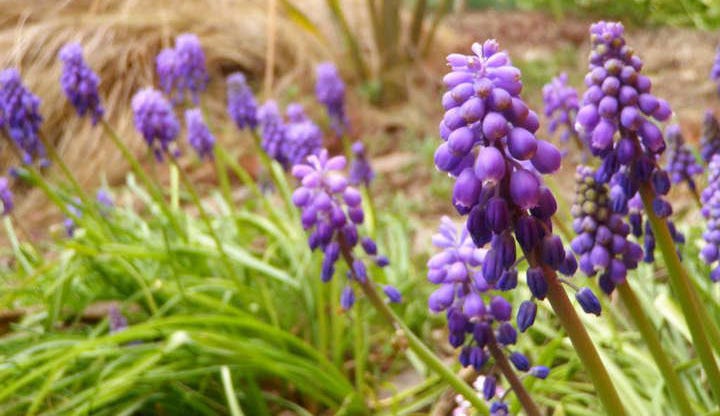Moving it Underground: Layering Large and Little Bulbs

Fall is coming! In the high country of New Mexico, the tallest mountain peaks are starting to collect some snow and the frosts down in town will become harder and more frequent. This is also the time of year when the action in our gardens will move underground.
Planting Spring-Bloming Flower Bulbs is one of the best ways to follow in nature’s footsteps by moving gardening underground, and finishing our garden chores for the year.
Small bulbs, including Crocus, Miniature Iris, and Muscari (Grape Hyacinths) are some of the very best spring bloomers. They are famous for waking up our gardens in the early spring.
The key to a great display of the small bulbs is to plant a lot of them. Planting small bulbs in drifts or patches of 48 bulbs or more will allow small flowers become a huge pool of color when they come into bloom together.
Fortunately, it's easy to plant lots of flower bulbs at once! You can maximize your spring bulb display by layering several bulbs in the same planting hole. That way, you can dig once, but plant for a variety of blooms! The rule of thumb is that the larger the bulb, the deeper it's planted. Follow our tips for layering your fall bulbs.

How To Layer Fall-Planted Bulbs
Layering your bulbs is a great way to maximize your spring bulb displays. In nature, different bulbs establish themselves at different depths in the soil, so we can imitate nature by doing it ourselves. Plant a large bulb and a small bulb (or two) in the same planting hole. It’s a great labor saver and makes the spring display that much longer and more colorful.
- For example, larger Daffodils or Tulip bulbs need to be planted at a depth of about 8 inches.
- So after dropping a daffodil or tulip into its hole and covering it with a few inches of dirt, you now have a 4 inch deep hole.
- Drop 2-4 Crocus, Miniature Iris or Muscari bulbs into the planting hole. Then fill with soil to ground level, water well, and you're done!
Tips:
- When planting bulbs be sure to have a bucket or wheelbarrow with a mixture of Yum Yum Mix (or Yum Yum Mix Winterizer), compost and soil ready. This way you can enrich the soil by simply filling the holes with the soil/compost/Yum Yum Mix blend.
- Water in your new bulb transplants with a good soaking
- Where appropriate, apply a couple inches of mulch to tuck them in.
These bulbs will live together harmoniously and multiply themselves to make even bigger showier patches over time.
In places of great bulb diversity like South Africa (the world’s epicenter for bulb species) there are often hundreds of bulbs and dozens of species in every square yard of ground, all growing at different depths in the soil.
A Reminder:
Above ground perennial plants are also moving their activity underground! Woody plants are busy transporting accumulated nutrients from the stems and leaves down into the roots, which are actively growing with the onset of the short days of fall. Perennials are doing the same thing, moving their stored nutrients from the dying stem and leaves down into their roots and crowns. This is, in part, why fall planting of many plants is so ideal: all of their energy goes into growing and expanding their root systems. So, don’t cut back your perennials until spring and wait to do pruning of woody plants until December or next year.
